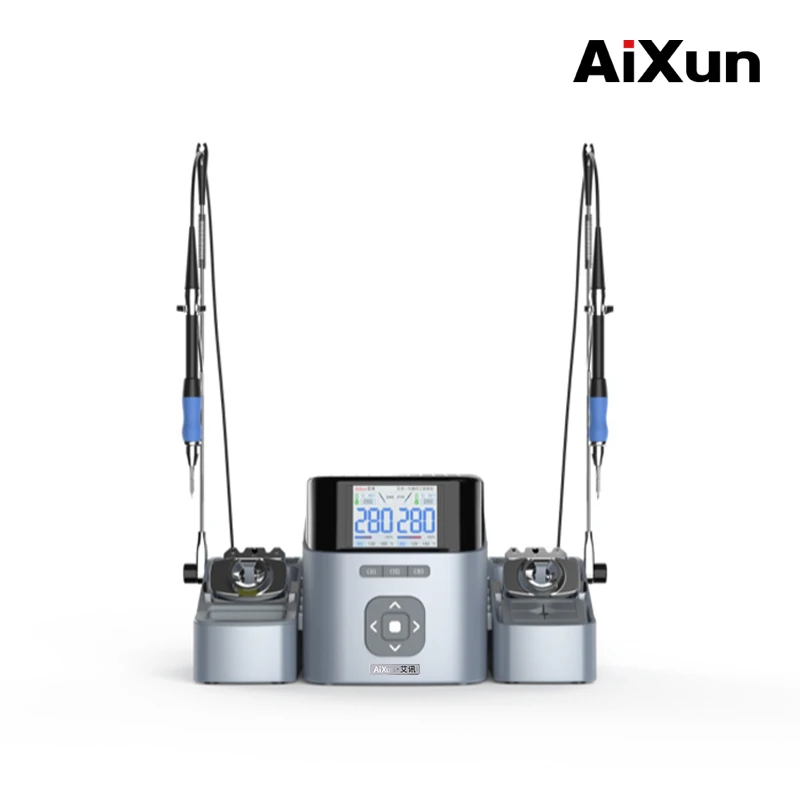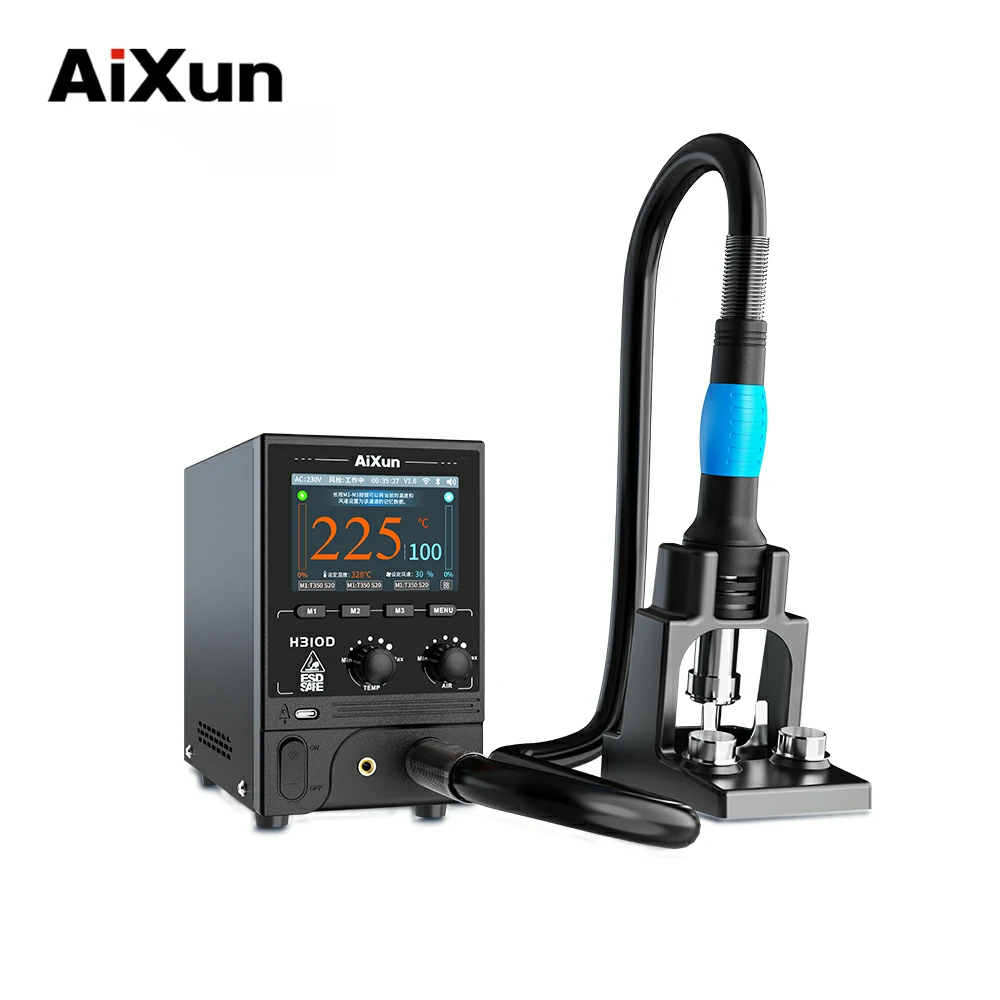
The soldering station is a manual soldering tool commonly used in the circuit board soldering process of electronic products. It welds two workpieces through the thermal melting and fusion of filler solder (usually tin wire).

The constant temperature electric Soldering station has two kinds of circuits: temperature control circuit and temperature digital display circuit. It is a manual soldering tool that works at low voltage. It has the functions of adjustable temperature, constant temperature and anti-static. The soldering tip of the constant temperature soldering station is a relatively delicate, small and thin tip, which is especially suitable for manual soldering of micro and small electronic components. It’s specially designed with fixed temperature screw to prevent the staff from misadjusting the temperature when soldering because of low efficiency. It is easy to cause problems such as over-soldering.
The working principle of the hot air soldering station is quite simple. The compressor produces a flow of air, which is heated to a certain temperature as it spirals through the heating element. The airflow from the heat gun is directed to the soldering area. Compared with the constant temperature soldering station, it is equipped with an extra hot air gun to facilitate the desoldering, and the control temperature is also about 200 ℃ ~ 480 ℃. The hot air soldering station is widely used for repairing mobile phones and household appliances. Any such workstation is powerful enough to operate with lead and lead-free solder alloys. However, they also have limitations in application. This soldering station cannot be used for soldering/desoldering of large BGA chips.

The high-frequency lead-free soldering station is an upgraded product of the constant temperature soldering station, which abandons the resistive ceramic heating element used by the traditional temperature-controlled soldering iron and replaced it by the principle of high-frequency eddy current heating (induction heating principle). Like the constant temperature soldering station, the high frequency lead-free soldering station is widely used. From the maintenance of common electronic appliances to electronic integrated circuits and chips, the soldering station is used as a soldering tool. Compared with the constant temperature soldering station, the high frequency lead-free soldering station is generally using high-frequency eddy current heating, the heating and temperature recovery speed is fast, which can help achieve lead-free soldering, and the power is generally as high as 90W-200W.
How to choose a soldering station is not only a topic for novices, but also for experienced engineers and technicians. And now that the Internet is so advanced, it’s inundated with various advertising promotions and reviews, and the question of which soldering station supplier is the best has made it difficult for consumers to choose.
It's no secret that modern devices, especially digital ones, are becoming more advanced and multifunctional every year, while their weight and size continue to decrease. This leads to difficulties in the assembly of electronic components during the manufacturing process and in repair and maintenance activities.
Soldering of PCB components in industry is done successfully by machines, but repair work is done by humans. Here, a successful outcome depends on the proficiency of the specialist and the equipment used. Since traditional soldering irons have become household tools, the soldering equipment market offers a wide range of professional soldering stations for repairing almost all modern equipment.
An electric soldering iron (soldering station) cannot be purchased with the traditional idea. The ordinary temperature-controlled electric soldering irons on the market, although marked as being able to be set to 400 degrees or higher, in fact, their heat capacity and temperature recovery ability are not enough to handle lead-free high-temperature soldering in the case of colder solder joints. During soldering, lead-free tin wire with a melting point higher than about 34°C has a relatively large heat dissipation capacity. If an ordinary temperature-controlled soldering station is used to solder without increasing the temperature (especially when the solder joint is large), it will cause tin burrs, virtual soldering and slow speed soldering due to insufficient heat energy replenishment. Therefore, in order to achieve a suitable soldering effect, it is necessary to increase the soldering temperature of the soldering iron accordingly, but it will bring many negative effects as well.
a. When soldering, we need to fill the Solder to help soldering, but lead-free tin wire is easier to oxidize than leaded soldering wire, (leaded soldering wire will produce harmful elements after heating with high temperature),and the high temperature bring scatalysis, the higher the temperature, the faster the oxidation rate. So soldering at extremely high temperatures is very likely to cause mechanical contact virtual soldering (the solder does not form an intermetallic molten alloy layer between the workpieces to be soldered) and the gray solder joints.
b. Ideally, it doesn’t need to wait too long for the storage of the soldering temperature and eliminate the storage of energy. Immediately add the energy obtained from the power source to the soldering place, which can not only avoid the loss of energy to the greatest extent but also achieve good soldering. But ordinary soldering irons cannot do that due to the slow heating speed. It can only achieve by increasing the temperature to store enough heat energy to ensure the temperature required by the soldering load, but the higher temperature will cause thermal shock to sensitive components, which will directly or indirectly affect the performance of the circuit and the performance of the entire circuit board. In severe cases, it may be scrapped.
c. Economically developed electronics factories, especially op to electronic product factories will have strict control over the setting of the soldering temperature. It’s better to set lower temperature on the premise of meeting soldering conditions. Therefore, the higher temperature cannot meet the soldering requirements set by the factory.

Therefore, when purchasing a soldering station (soldering iron), you must ensure three points first:
1)Ensure that the soldering temperature is about 350°C
2)Ensure that the soldering speed is 3-4 seconds for one solder joint
3)For security assurance, be sure to choose a soldering station with brand, here are some better brands recommended: JBC, HAKKO, AIXUN.....
 WhatsApp
WhatsApp